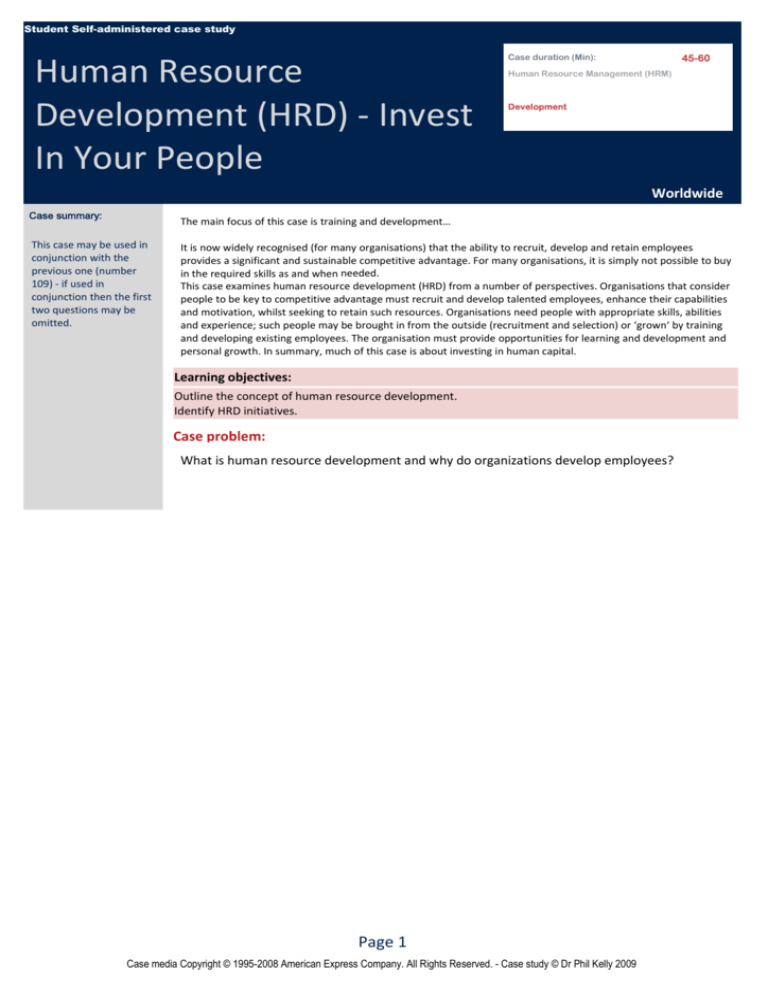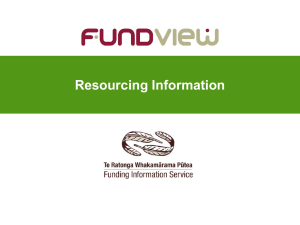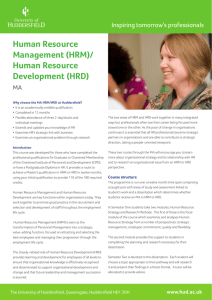
Student Self-administered case study
Human Resource Development (HRD) ‐ Invest In Your People
45-60
Case duration (Min):
Human Resource Management (HRM)
Development
Worldwide
Case summary:
The main focus of this case is training and development…
This case may be used in conjunction with the previous one (number 109) ‐ if used in conjunction then the first two questions may be omitted.
It is now widely recognised (for many organisations) that the ability to recruit, develop and retain employees provides a significant and sustainable competitive advantage. For many organisations, it is simply not possible to buy in the required skills as and when needed. This case examines human resource development (HRD) from a number of perspectives. Organisations that consider people to be key to competitive advantage must recruit and develop talented employees, enhance their capabilities and motivation, whilst seeking to retain such resources. Organisations need people with appropriate skills, abilities and experience; such people may be brought in from the outside (recruitment and selection) or ‘grown‘ by training and developing existing employees. The organisation must provide opportunities for learning and development and personal growth. In summary, much of this case is about investing in human capital.
Learning objectives:
Outline the concept of human resource development.
Identify HRD initiatives.
Case problem:
What is human resource development and why do organizations develop employees?
Page 1
Case media Copyright © 1995-2008 American Express Company. All Rights Reserved. - Case study © Dr Phil Kelly 2009
First, if you are taking a taught management course then consult with your tutor and ensure that the case has not been scheduled into a teaching class or
tutorial. If it has not:
1. Play/ read the media associated with the case. You may need to access the Internet and enter a URL to locate any video clips.
2. Attempt the Case study questions.
Consider attempting the case study as a group exercise; you could form a study group with fellow students.
3. Check the suggested answers - remember these are suggestions only and there are often many possible answers.
Discuss questions and answers with other students.
4. If you feel your answer(s) were weak then consider reading the relevant suggested readings again (also see the case study suggested references).
Title/
Media type
Invest In Your People:
Film
URL/ Media description
http://www.openforum.com/idea‐hub/topics/managing/video/invest‐in‐your‐
people‐ces‐roundtable
How do you find – and retain – employees who share your vision for your business? Gain insights from three cutting‐edge entrepreneurs whose companies are focused on creating cultures that inspire top talent.
NOTES:
Page 2
Case media Copyright © 1995-2008 American Express Company. All Rights Reserved. - Case study © Dr Phil Kelly 2009
Case study questions... Pre/During/After
class
Action
1
KEY CONCEPTS:
2
HUMAN RESOURCE DEVELOPMENT:
During
Discuss the meaning of human resource management, human resource planning, employee resourcing and
human resource development. Is there any overlap in the meaning of these concepts? How do the concepts
relate to each other?
During
In your groups, discuss the function and purpose of human resource development and expand on your
definition of the concept, highlighting key principles.
3
EDUCATION AND TRAINING:
4
POACHING
During
Human capital development (investing in people) in the form of education and skills training can be an effective
response to constraints imposed on the employment market (specific skills may be in short supply). Not only
should this improve productivity through ability but also through enhanced motivation. However, in many
organisations there remains a reluctance of employers to engage in training-with reference to the film clip and
your wider experience, identify and discuss possible reasons for this.
During
Tom Callaghan highlighted the poaching problem in the first part of the film clip. This was reiterated by Noel Lee
of Monster Cable products who stated, ‘we spend all this money training people and then they leave…’.
Organisations may be unwilling to invest in the development of their employees because they do not know
whether they themselves, rather than some other employer, will benefit from the investment. In your groups,
discuss the problem of poaching and its impact upon the decision to invest in training-what would you
recommend to employers?
Page 3
Case media Copyright © 1995-2008 American Express Company. All Rights Reserved. - Case study © Dr Phil Kelly 2009
Answers... HUMAN RESOURCE DEVELOPMENT (HRD)
A strategic approach to investing in human capital. It draws on other human resource processes, including resourcing and performance assessment to identify actual and potential talent. HRD provides a framework for self‐development, training programmes and career progression to meet an organization’s future skill requirements.
HUMAN RESOURCE PLANNING
A strategy for the acquisition, utilisation, improvement and retention of an organisation's human resources.
TRAINING
Any intervention aimed at increasing an individual’s knowledge or skills
TRAINING AND DEVELOPMENT
The building of competencies and skills of individual employees, to enable them to improve work performance and achieve organizational goals.
Question/ Answer
1 KEY CONCEPTS:
Discuss the meaning of human resource management, human resource planning, employee resourcing and human resource development. Is there any overlap in the meaning of these concepts? How do the concepts relate to each other?
Human resource management - A philosophy of people management based on the belief that
human resources are uniquely important to sustained business success. An organization gains
competitive advantage by using its people effectively, drawing on their expertise and ingenuity to
meet clearly defined objectives. HRM is aimed at recruiting capable, flexible and committed
people, managing and rewarding their performance and developing key competencies. See also
‘Hard HRM’, ‘Soft HRM’
Human resource planning - A strategy for the acquisition, utilisation, improvement and retention
of an organisation's human resources.
Employee resourcing - Resourcing is the process by which people are identified and allocated to
perform necessary work. Resourcing has two strategic imperatives: first, minimizing employee
costs and maximizing employee value to the organization; secondly, obtaining the correct
behavioural mix of attitude and commitment in the workforce.
Human resource development (HRD) - A strategic approach to investing in human capital. It
draws on other human resource processes, including resourcing and performance assessment, to
identify actual and potential talent. HRD provides a framework for self-development, training
programmes and career progression to meet an organization’s future skill requirements.
As a philosophy, HRM provides guiding principles for all aspects of people management within
organisations; consequently, we might consider the other three constructs as subordinate to it.
Similarly, human resource planning (as defined above) might be seen to encompass both employee
resourcing and human resource development. However, some scholars and practitioners may use
the term resourcing more widely. Human resource development processes may closely interact
with performance management and may have the objective of enhancing organisational
capabilities and getting the most out of human capital. Some practitioners use the terms training
and development interchangeably.
2 HUMAN RESOURCE DEVELOPMENT:
In your groups, discuss the function and purpose of human resource development and expand on your definition of the concept, highlighting key principles.
Human resource development and learning in the workplace may enhance employee motivation,
improve skills and capabilities and therefore performance, and provide opportunities for personal
growth. Benefits may be reflected in sustainable competitive advantage, productivity gain, and the
retention of talented employees (thus reducing costs associated with resourcing, recruitment and
selection, managing employee turnover and the leakage of knowledge or intellectual capital).
Principal elements of human resource development may include the identification and
improvement of skills and motivation, training needs identification and the provision of training
programmes or opportunities for personal growth and self development.
Scholars and practitioners have argued that it is the workforce itself (when highly skilled and
motivated) that constitutes a source of sustainable competitive advantage. An organization not
only needs skilled people, these people must also be well managed. Whilst any given employee may
be talented they may not necessarily apply that talent to perform (see discretionary behaviour). In
short, competitive advantage is also dependent upon the employee choosing to engage in
behaviour that will benefit the organization. There are many practices that seek to influence
behaviour. Huselid (1995) revealed a relationship between HR practice and performance (return
on assets); Koch and McGrath (1996) found that HR practices (recruitment and staffing) were
related to productivity and Wright et al (1999) linked appraisal and training practices with skill
development and compensation practice with motivation. Sustainable competitive advantage is
not just a function of isolated components but rather a combination of skills, behaviour and the
supporting People Management or HR System. HR activities are thought to lead to the
development of a skilled workforce and one that engages in functional behaviour for the
organization; this results in higher operating performance, which translates into increased
profitability.
According to Bartlett and Ghoshal (2002) skilled and motivated people are central to the
operations of any company that wishes to flourish in the new age – ‘In short, people are the key
strategic resource, and strategy must be built on a human-resource foundation’. It is widely
accepted that in order to compete in a rapidly changing environment, companies must continually
improve their performance by reducing costs, innovating products and processes, and improving
quality, productivity and speed to market, (Becker and Gerhart 1996). HR systems represent a
largely untapped opportunity to improve company performance.
Page 4
Case media Copyright © 1995-2008 American Express Company. All Rights Reserved. - Case study © Dr Phil Kelly 2009
3 EDUCATION AND TRAINING:
Human capital development (investing in people) in the form of education and skills training can be an effective response to constraints imposed on the employment market (specific skills may be in short supply). Not only should this improve productivity through ability but also through enhanced motivation. However, in many organisations there remains a reluctance of employers to engage in training‐with reference to the film clip and your wider experience, identify and discuss possible reasons for this.
1. Cost-cost features in several ways. Firstly, training often involves capital expenditure and the
financial resource could be used for other things. Many employers have a short term mindset and
prefer to invest in initiatives that give a more immediate return. The benefits of training may take
longer to manifest.
2. Difficulties in proving that training results in improved efficiency and productivity
3. Poaching-as was highlighted by Tom Callaghan in the film clip, ‘ we typically build them up… w
organically grow them within our company but then if we teach them enough, they learn enough..
often they jump to a competitor or start their own firm’ (training your competition).
4 POACHING
Tom Callaghan highlighted the poaching problem in the first part of the film clip. This was reiterated by Noel Lee of Monster Cable products who stated, ‘we spend all this money training people and then they leave…’. Organisations may be unwilling to invest in the development of their employees because they do not know whether they themselves, rather than some other employer, will benefit from the investment. In your groups, discuss the problem of poaching and its impact upon the decision to invest in training‐what would you recommend to employers?
This is a difficult problem for employers, as Noel Lee of Monster Cable Products went on to say,
what if you do not train them and they stay? The organisation is dependent upon a skilled,
motivated and talented workforce. Skills may either be bought in or home-grown. It may not
always be possible to acquire the skills from the marketplace. It then becomes important to
cultivate talent. As Noel Lee suggests, we have to train people, we have to invest in our people.
Organisations attempt to deal with this problem is a number of ways. They may use the employee
contract as a mechanism to tie the employee (recipient of training) to the company to ensure
benefits are realised or they may use other mechanisms to improve employee satisfaction in the
hope that they stay with the company; as Kristian Rauhala of H2O Audio suggested-whilst we may
not be able to compete on salary, we offer a lifestyle, stock options, leadership, culture and
desirable work environment.
Other organisations may consider their policy toward training. This may be different dependent
upon whether the acquired skills are to be of a general nature or specific to the training company.
Specific skills will be, arguably, of less benefit to competing organisations whilst general skills are
transferable. Consequently, the organisation may be more inclined to invest in specific rather than
general training. Such organisations may expect the employee to make a greater contribution to
the acquisition of general skills.
Case study references
Cole, G A. and Kelly, P P. (2011) 'Management Theory and Practice', Ed. 7. Cengage EMEA.
Price, A. (2007) 'Human Resource Management in a Business Context', Ed. 3. Cengage Learning EMEA.
Page 5
Case media Copyright © 1995-2008 American Express Company. All Rights Reserved. - Case study © Dr Phil Kelly 2009





